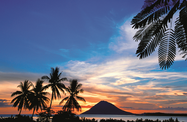Plans by major cruise tourism companies to include Papua New Guinea (PNG) on their itineraries and a joint marketing initiative with a northern Australian region have provided an important boost to PNG’s expanding tourism industry.
In mid-May, leading cruise tourism company Carnival Australia announced that a series of cruises run by UK-based P&O Cruises will begin stopping in PNG in October 2013. Prime Minister Peter O’Neill hailed the announcement as the result of years of hard work by PNG Ports and the PNG Tourism Promotion Authority (TPA) to develop cruise tourism.
“We are taking steps to ensure cruising becomes an important contributor to our nation,” O’Neill said. “Infrastructure improvements are part of that strategy.”
P&O Cruises also recently added two dedicated PNG cruise itineraries to its 2013-14 programme. According to Ann Sherry, the CEO of Carnival Australia, “PNG is one of the most remote and untouched corners of the world. It is so close to Australia geographically, but 1m miles away in terms of its amazing scenery and fascinating culture.”
In the same week, officials from the Queensland region of Australia revealed that its town of Cairns, which lies just 844 km from PNG and enjoys historic cultural links with the island, wants to establish a joint marketing initiative in tourism.
When speaking with Radio Australia on May 14, Campbell Charlton, the chairman of Advance Cairns, said the 2.2m visitors that visit Queensland each year to see the Great Barrier Reef and the region’s rainforest areas represent a huge visitor pool that PNG can tap into.
“PNG has some exclusive tourism products that those same visitors would like to see,” said Charlton, adding that his region is now attracting more adventure-minded travellers who view PNG as a prime onward destination, as it offers unique trekking opportunities and has “enormous” potential in nature-based travel, such as bird-watching.
Under the initiative, there are also plans to develop PNG Customs and pre-clearance at Cairns airport so that when tourists board the plane there, they will essentially be on a domestic flight. Direct air links to tourism destinations, such as smaller islands and Madang, which boasts many of the country’s highest peaks and active volcanoes, could also be established.
Both the cruises and the link-up with Cairns will enable the island to build on the strong growth tourism registered in 2011, when total arrivals grew by 14% year-on-year (y-o-y) to 164,000. The direct contribution of travel and tourism to GDP was $129.78m, or 0.9% of total GDP, in 2011. This figure is forecast to rise by 3.8% in 2012 and by 4.7% per year between 2012 and 2022, according to the World Travel & Tourism Council. The industry currently employs 20,500 people, but this is expected to grow to 26,000 by 2022.
This recent expansion was likely boosted by the efforts of the TPA, which partnered with industry players to promote PNG’s cultural diversity and adventure tourism products under the tagline, “A million different journeys”.
Improving the image of the capital has also been a key strategy, with the growing number of accommodation offerings in Port Moresby receiving a significant boost from the opening of the Steamships Trading Company’s 160-room, $95.81n Grand Papua Hotel.
As part of major projects identified under the Tourism Master Plan 2007-17, the PNG-TPA in April also introduced the country’s first Accommodation Quality Assurance Programme, which provides a guide for operators, developers and hotel owners on how to build and operate their properties. Jerry Agus, the director of policy and planning at TPA, said that the programme will provide “TPA and other organisations marketing PNG with an international grading system that is recognised by the travel trade”.
However, despite the nation’s progress in attracting more tourists, local operators say the government needs to do more to incentivise the industry. “We need a major improvement of our image, reduction in crime, lower airfares and hopefully direct airfares between Madang and Cairns so we can bypass Port Moresby,” said Peter Barter, a Madang tour operator, when speaking with Islands Business in January.
Taking steps to tackle such root issues hampering the growth of the tourism industry will surely make it easier to increase the sector’s contribution to the economy and make the most of recent partnerships.

